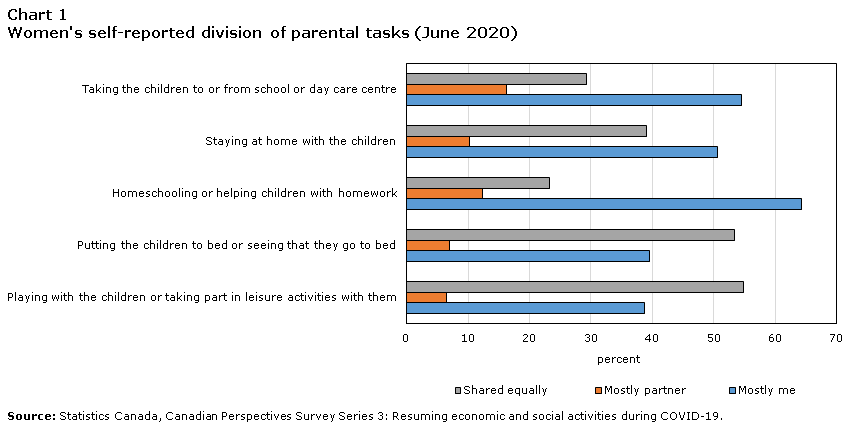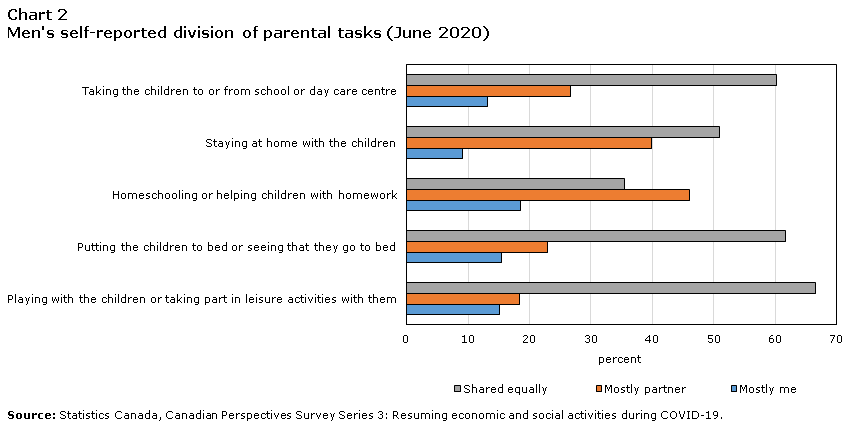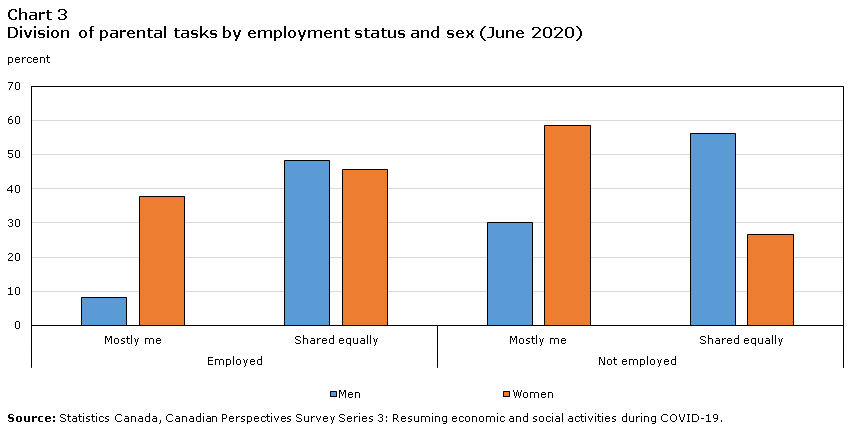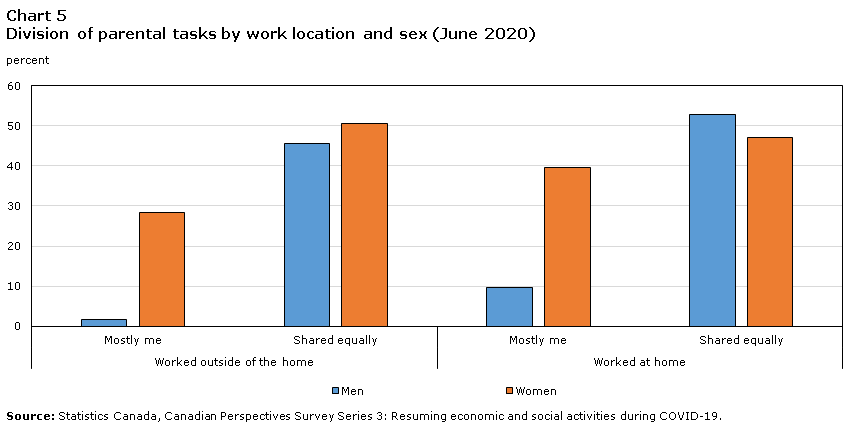 StatCan COVID-19: Data to Insights for a Better Canada Caring for their children: Impacts of COVID-19 on parents
StatCan COVID-19: Data to Insights for a Better Canada Caring for their children: Impacts of COVID-19 on parents
by Karine Leclerc
Text begins
For families with children, the closure of schools and childcare facilities due to the COVID-19 pandemic has significantly disrupted their daily routines. As a result, parents’ caregiving responsibilities in relation to children have increased, along with concerns about balancing child care, schooling and work (Statistics Canada 2020).
Prior to the pandemic, women in Canada tended to perform a larger share of parental tasks than men. In 2015, for example, mothers spent an average of 2.6 hours per day on child care as a primary activity compared to 2 hours for fathers (Moyser 2018). A key question in the context of the pandemic, then, is whether the closure of schools and childcare facilities has deepened the pre-existing gender-based division of parental tasks within families.Note
Using data from the Canadian Perspectives Survey Series 3: Resuming Economic and Social Activities during COVID-19, this article examines how gender influences the division of parental tasks within families during the pandemic. For this reason, the analysis is limited to respondents who were living with a spouse or partnerNote (hereafter referred to as "partner") at the time of the survey, and who reported performing any one of five parental tasks during the pandemic: playing with children or taking part in leisure activities with them; putting children to bed or seeing that they go to bed; homeschooling or helping children with homework; staying at home with the children; and taking children to or from school or day care.
Women are more likely to report that they perform most parental tasks, but men are more likely to indicate that the tasks are shared equally
The majority of women and men reported that playing with children or taking part in leisure activities with them were shared equally with their partner (55% and 67% respectively) as was putting them to bed or seeing that they go to bed (53% and 62%, respectively) (Charts 1 and 2). For other parental tasks – specifically, staying at home with children and taking children to or from school or day care – most women reported that they largely performed these by themselves (51% and 55%, respectively), while most men reported that these parental tasks were shared equally with their partner (51% and 60%, respectively).

Data table for Chart 1
| Playing with the children or taking part in leisure activities with them | Putting the children to bed or seeing that they go to bed | Homeschooling or helping children with homework | Staying at home with the children | Taking the children to or from school or day care centre | |
|---|---|---|---|---|---|
| percent | |||||
| Mostly me | 38.7 | 39.6 | 64.3 | 50.6 | 54.6 |
| Mostly partner | 6.4 | 7.1 | 12.4 | 10.3 | 16.2 |
| Shared equally | 54.9 | 53.3 | 23.3 | 39.1 | 29.2 |
| Source: Statistics Canada, Canadian Perspectives Survey Series 3: Resuming economic and social activities during COVID-19. | |||||

Data table for Chart 2
| Playing with the children or taking part in leisure activities with them | Putting the children to bed or seeing that they go to bed | Homeschooling or helping children with homework | Staying at home with the children | Taking the children to or from school or day care centre | |
|---|---|---|---|---|---|
| percent | |||||
| Mostly me | 15.2 | 15.5 | 18.5 | 9.2 | 13.2 |
| Mostly partner | 18.3 | 22.9 | 46.1 | 39.9 | 26.6 |
| Shared equally | 66.5 | 61.6 | 35.5 | 51.0 | 60.2 |
| Source: Statistics Canada, Canadian Perspectives Survey Series 3: Resuming economic and social activities during COVID-19. | |||||
This pattern, where women were more likely to report that they did more parental tasks than men while men were more likely to report that these responsibilities were shared equally with their partner, is consistent with previous studies (Pew Research Centre 2015). Research shows that men tend to overestimate the time they spend on unpaid family work, particularly when this information is collected using stylized questions (i.e. respondents are asked to answer questions about their activities retrospectively) instead of time diaries (i.e. respondents are asked to record their activities over a period of time in a diary) (Kan 2008; Henchoz & Wernli 2013; UN 2005).
Homeschooling falls mostly to women
For most parents, homeschooling was an additional responsibility directly related to the closure of schools during the pandemic, and this extra parental task was predominantly undertaken by women. The majority of women (64%) reported that they mostly performed homeschooling or helping children with homework, while 19% of men reported being mostly responsible for this task (Charts 1 and 2). When men were asked, almost half (46%) reported that homeschooling was mostly their partner’s responsibility.
This gendered division of responsibility related to homeschooling, added to other parental tasks, may put parents – and especially mothers – at higher risk of increased life stress. Indeed, previous results on the impact of the measures to counter COVID-19 suggest that balancing child care, schooling and work during the pandemic raises high levels of concerns for parents and that there may be mental health consequences for those who feel additional stress related to family responsibilities (Statistics Canada 2020). While schools, economic and social activities have resumed, there may be future school closures as a result of future waves of COVID-19. In addition, many children in a number of provinces are continuing their studies virtually from home. As such, there may be an on-going demand on parents, in particular mothers.
Men who are not employed are more likely to report that parenting tasks are shared equally, but it is the opposite for women who are not employed
Results from the Canadian Perspectives Survey, showed that employment statusNote has differential impacts on the division of parental tasks. On the one hand, not being employed increased the likelihood of taking on the role of primary caregiver – for both men and women. On the other hand, there is a gendered difference with regards to sharing parental tasks equally.
Indeed, parents who were not employed were more likely to report they were mostly responsible for parenting tasks than among those who were employed. For example, the proportion of men who reported that they mostly performed parental tasks was 30% among those who were not employed compared with 8% among those who were employed (Chart 3). For women, the proportion was 59% among those who were not employed compared with 38% among those who were employed (Chart 3).
However, when it comes to the proportion of parents who said they shared tasks equally, the patterns were different for men and women. Men who were not employed were more likely to report that parental tasks were shared equally (56%) than men who were employed (48%) (Chart 3). In contrast, women who were not employed were less likely to report that these tasks were shared equally (27%) than women who were employed (46%) (Chart 3).

Data table for Chart 3
| Employed | Not employed | |||
|---|---|---|---|---|
| Mostly me | Shared equally | Mostly me | Shared equally | |
| percent | ||||
| Men | 8.3 | 48.3 | 30.1 | 56.0 |
| Women | 37.8 | 45.5 | 58.6 | 26.6 |
| Source: Statistics Canada, Canadian Perspectives Survey Series 3: Resuming economic and social activities during COVID-19. | ||||
The findings on the relationship between parenting duties and employment are consistent with trends observed in the 2015 General Social Survey on Time Use which shows that there is an inverse relationship between the number of hours of paid work and the time spent helping and caring for children for both fathers and mothers (Houle et al., 2017). It also found that mothers remained more likely than fathers (in almost all categories of number of hours of paid work) to have helped their children or provided child care (Houle and al., 2017).
Men working at home favours more equal parenting, but it is the opposite for women who work at home
Men and women who worked from home at the time of the survey were more likely than their counterparts who worked outside of the home to take on a greater parental role (Chart 4).Note However, women remained more likely than men to report mostly performing these parental tasks regardless of their work location (Chart 4 and 5). In fact, the proportion of men working from home who reported that they mostly perform parental tasks remained lower for every parental task than the proportion of women working outside of the home who reported that they mostly perform these tasks (Chart 4).

Data table for Chart 4
| Men | Women | |||
|---|---|---|---|---|
| Worked outside of the home | Worked at home | Worked outside of the home | Worked at home | |
| percent | ||||
| Playing with children or taking part in leisure activities with them |
7.1 | 12.8 | 23.9 | 33.3 |
| Putting children to bed or seeing that they go to bed |
10.2 | 17.2 | 27.5 | 37.9 |
| Homeschooling or helping children with homework |
6.2 | 24.0 | 45.0 | 69.2 |
| Source: Statistics Canada, Canadian Perspectives Survey Series 3: Resuming economic and social activities during COVID-19. | ||||
Similar to the relationship between parenting duties and employment status, the overall impact of the work location was different for men and women. Men who worked at home (53%) were more likely than men who worked outside of the home (46%) to report that parental tasks were shared equally (Chart 5). In contrast, women who worked at home (47%) were less likely than women who worked outside of the home (51%) to report that parental tasks were shared equally and they were more likely to report that they mostly performed these tasks themselves (40% vs. 28% respectively) (Chart 5).

Data table for Chart 5
| Worked outside of the home | Worked at home | |||
|---|---|---|---|---|
| Mostly me | Shared equally | Mostly me | Shared equally | |
| percent | ||||
| Men | 1.8 | 45.7 | 9.6 | 52.8 |
| Women | 28.3 | 50.6 | 39.7 | 47.2 |
| Source: Statistics Canada, Canadian Perspectives Survey Series 3: Resuming economic and social activities during COVID-19. | ||||
Using the American Time Use Surveys and the US COVID Impact Survey, a recent American study on the gender differences in telecommuting (working from home) shows similar results (Lyttelton et al., 2020). The study finds that, during the pandemic, the parents’ response to telecommuting was gendered, in ways that both exacerbated and alleviated existing gender inequalities. Specifically, it shows that telecommuting during the pandemic increased time spent on childcare for both fathers and mothers – compared to those who worked outside of the home. However, it also finds that telecommuting mothers did relatively more parenting tasks than telecommuting fathers.
Conclusion
Parents are facing new challenges in the context of the COVID-19 pandemic as it has disrupted the daily routines of families. For many parents, the closure of schools and daycares intensified parental tasks and added new responsibilities, such as homeschooling.
Prior to the pandemic, women in Canada performed a larger share of parental tasks and, during the pandemic, they continued to report that they mostly perform these tasks. The results of the survey show, however, that employment status and work location affect the division of parental tasks within couples and may increase men’s level of involvement in parenting responsibilities. When men are not employed and/or when men work at home it seems to favour a better share of parental tasks as men in these situations were more likely to say parenting tasks were equally shared compared with men who were employed or worked outside the home. However, when it is the contrary, i.e. when women are not employed and/or are working from home, they are more likely to report that they mostly performed parental tasks (and are less likely to report that these responsibilities are shared equally).
The unequal division of unpaid family work is not without effects; it has long been recognized as a driver of gender inequality as it has direct impacts on women’s labour force participation, time spent at work, wages and job quality, and physical and mental health stressors (UN Women 2020).
Methodology
This article uses data from the Canadian Perspectives Survey Series (CPSS) wave 3, for which a panel of Canadians selected from the Labour Force Survey (LFS) rotation groups agreed to complete short online surveys. The CPSS is a probabilistic panel survey and is therefore representative of the general population. More than 4,200 people (of which about 2,750 persons reported living with a spouse or a partner and 970 reported participating in parental tasks) from the 10 provinces responded to this survey between June 15 and June 21, 2020.
In the Family and Caregiving Recovery section of CPSS wave 3, respondents were asked if they were currently living with a spouse or a partner and who performed a series of parental tasks. The possible answers were: mostly you; mostly your spouse or partner; shared equally between spouse or partner; always or usually someone else (e.g., relative, child, roommate); and, not applicable (i.e., no one performed these tasks). For this analysis, only respondents who were living with a spouse or partner and who reported performing any one of five parental tasks during the pandemic (referred to as "parents" in the paper) were studied. Of note, there was no question on the duration of these parental activities and the survey did not ask if their respective partners would agree with the respondents’ perceptions of who is mostly responsible for these parental tasks. Also, no questions (such as employment status, work location, or gender) were asked about the spouse or partner of the respondents. As such, by solely using CPSS, information on respondents’ partners was not available and not used in this paper.
References
Henchoz, Caroline and Boris Wernli. 2013. “Satisfaction with the Division of Household Tasks in Switzerland: A Longitudinal Approach”, in Population, Vol. 68, Issue 4, pp. 533-556. Online: https://www.cairn-int.info/article-E_POPU_1304_0533--satisfaction-with-the-division-of-house.htm#
Houle, Patricia, Turcotte, Martin, and Michael Wendt. 2017. “Changes in parents’ participation in domestic tasks and care for children from 1986 to 2015” in Spotlight on Canadians: Results from the General Social Survey, Statistics Canada Catalogue no. 89-652-X2017001. Online: https://www150.statcan.gc.ca/n1/pub/89-652-x/89-652-x2017001-eng.htm
Kan, Man Yee. 2008. Measuring Housework Participation: The Gap Between “Stylised” Questionnaire Estimates and Diary-Based Estimates. Online: https://www.researchgate.net/publication/225682128_Measuring_Housework_Participation_The_Gap_Between_Stylised_Questionnaire_Estimates_and_Diary-Based_Estimates
Lyttelton, Thomas, Zang, Emma, and Kelly Musick. 2020. “Gender Differences in Telecommuting and Implications for Inequality at Home and Work”, in SocArXiv Papers. Online: https://osf.io/preprints/socarxiv/tdf8c/
Moyser, Melissa. 2018. “Time use: Total work burden, unpaid work, and leisure”, in Women in Canada: A Gender-based Statistical Report. Statistics Canada Catalogue no. 89-503-X.
PEW Research Center. 2015. Raising Kids and Running a Household: How Working Parents Share the Load. Online:https://www.pewresearch.org/wp-content/uploads/sites/3/2015/11/2015-11-04_working-parents_FINAL.pdf
Savage, Katherine and Martin Turcotte. 2020. “Commuting to work during COVID-19”, in STATCAN COVID-19: Data to insights for a better Canada, Statistics Canada Catalogue no. 45280001. Online: https://www150.statcan.gc.ca/n1/pub/45-28-0001/2020001/article/00069-eng.htm
Statistics Canada. 2017. Census in Brief: Same-sex couples in Canada in 2016. Catalogue no. 98-200-X.
Statistics Canada. 2020. “Impacts of COVID-19 on Canadian families and children”, in The Daily (July 9), catalogue no. 11-001-X.
UN. 2005. Guide to Producing Statistics on Time Use: Measuring Paid and Unpaid Work. Online: https://unstats.un.org/unsd/publication/SeriesF/SeriesF_93E.pdf
UN Women. April 2020. Policy Brief: The Impact of COVID-19 on Women. Online: https://www.empowerwomen.org/en/resources/documents/2020/04/policy-brief-the-impact-of-covid-19-on-women?lang=en
Zossou, Clémence. Forthcoming. “Sharing household tasks: Teaming up during the COVID-19 pandemic” in STATCAN COVID-19: Data to Insights for a Better Canada, Statistics Canada Catalogue no. 45280001.
- Date modified: